Eerie image of glowing, red-eyed rat fetus during its 21st day of development wins prestigious science photography prize
- Winners of Olympus's Image of the Year Life Science Light Microscopy have been announced
- The global winning image is a rat fetus with glowing eyes that was snapped on its 21st day of development
- Regional winners include a panorama of l glutamine and beta alanine crystals and snake skin cells
- Also included is a mesmerizing image of more than 40 butterfly wings placed in a circular design
- The competition was focused on living organisms as seen through any type of microscope
A stunning image of a rat fetus with glowing red eyes and iridescent tissue has been named winner of a prestigious science photograph prize.
Scientist Werner Zuschratter captured the embryo on its 21st day of development using a microscope that shoots images through a tiny pinhole to highlight contrasts and increase clarity.
Along with Zuschratter's winning masterpiece, judges chose a photo showing intricate details of pigment cells in snake skin and a collage of more than 40 colorful butterfly wings as regional runner ups.
The competition, hosted by Olympus's Life Sciences division, is the second-ever Global Image of the Year Life Science Light Microscopy, which focuses on living organisms as seen through any type of microscope.
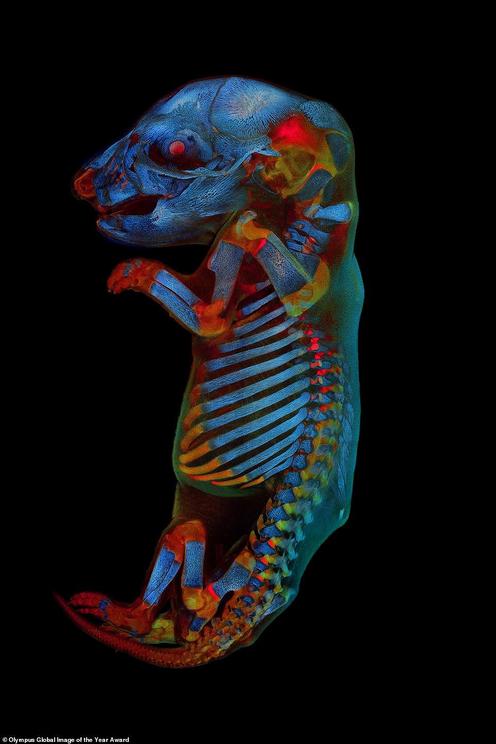 A rat fetus with red, devilish eyes and glowing tissue has been named winner of the second-ever Global Image of the Year Life Science Light Microscopy. Scientist Werner Zuschratter captured the embryo on its 21st day of development using a microscope that
A rat fetus with red, devilish eyes and glowing tissue has been named winner of the second-ever Global Image of the Year Life Science Light Microscopy. Scientist Werner Zuschratter captured the embryo on its 21st day of development using a microscope that
The global competition received nearly 700 submissions from 61 different counties.
As Satoshi Nakamura, Vice President of Scientific Solutions Global Marketing at Olympus, highlights: 'Not only did we see a record number of submissions, but the quality and creativity of those images were exceptional. It's amazing to see the unexpected art people capture with a microscope.'
Zuschratter from Germany was selected as the global winner for his eye-catching image of a whole rat embryo captured with a confocal microscope.
He told LiveScience that the embryo measures just 1.2 inches long, and had been treated in a chemical to make its skin and muscles translucent.
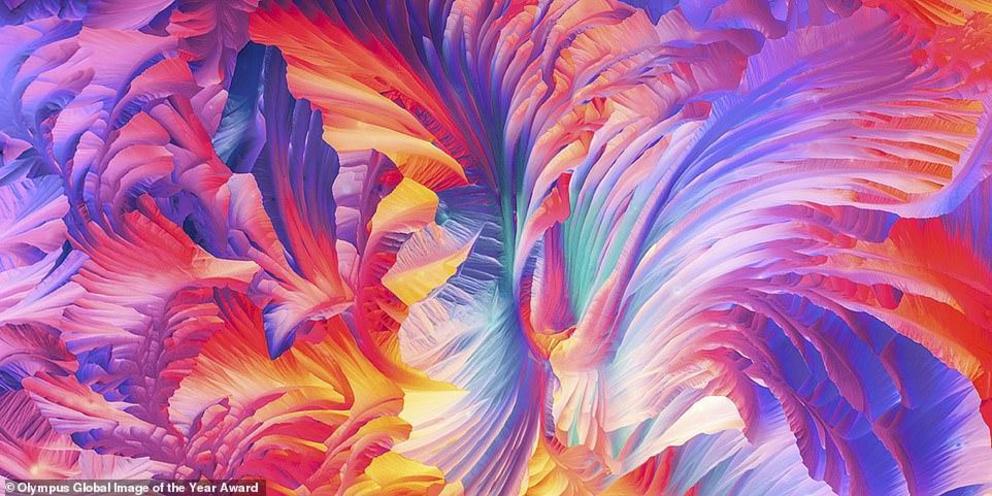 Justin Zoll won the Americas regional prize for his beautiful polarized light microscopy panorama of l glutamine and beta alanine crystals. This microscope uses a contrast-enhancing technique that improves the quality of the image
Justin Zoll won the Americas regional prize for his beautiful polarized light microscopy panorama of l glutamine and beta alanine crystals. This microscope uses a contrast-enhancing technique that improves the quality of the image
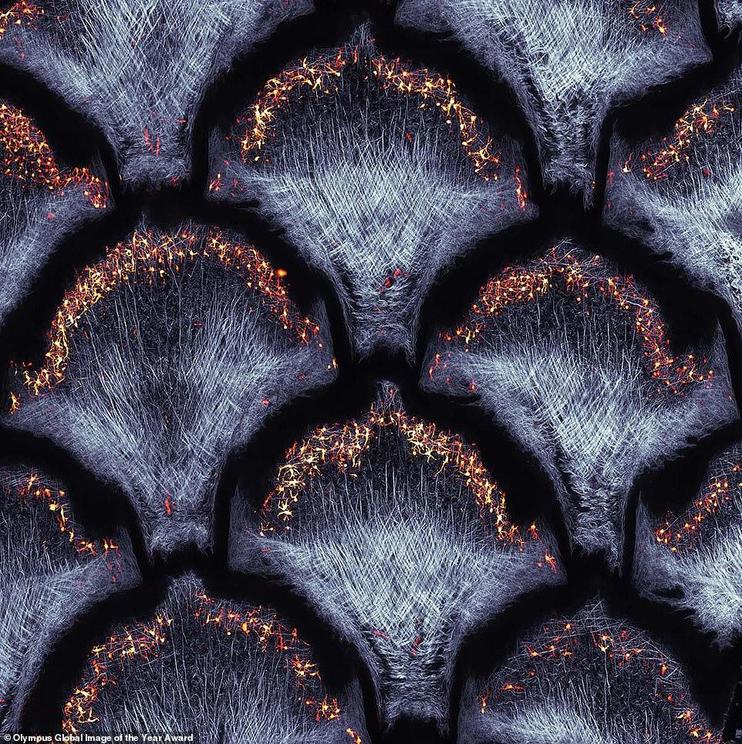 An incredible confocal image of collagen fibers (second harmonic generation) and dermal pigment cells (autofluorescence) in African house snake embryonic skin from Grigorii Timin, Switzerland, won the EMEA section. Timin used the same microscope as Zuschr
An incredible confocal image of collagen fibers (second harmonic generation) and dermal pigment cells (autofluorescence) in African house snake embryonic skin from Grigorii Timin, Switzerland, won the EMEA section. Timin used the same microscope as Zuschr
In the image, the tissue and skeleton of the fetus appear to be glowing in deep reds, blues and greens, which was done through the use of fluorescent dyes and natural fluorescence in body tissues.
Zuschratter explained he scanned the embryo multiple times with a laser and then combined the images – all of which took more than 25 hours to complete.
The competition chose three regional winners who presented images that were just as captivating as the rat fetus.
Justin Zoll won the Americas regional prize for his beautiful polarized light microscopy panorama of l glutamine and beta alanine crystals
This microscope uses a contrast-enhancing technique that improves the quality of the image.
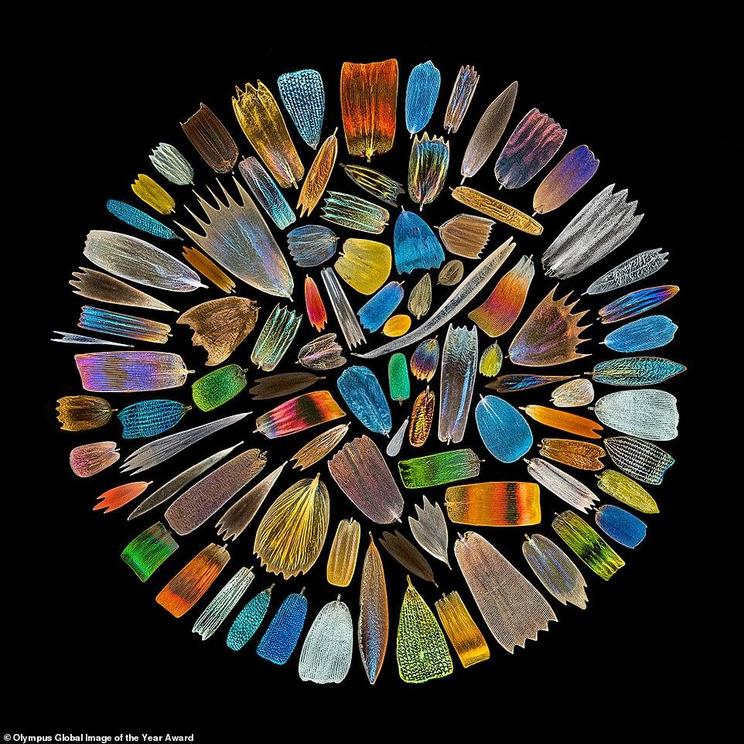 In the Asia-Pacific section, scales collected from the wings of over 40 species of butterflies were photographed individually and thoughtfully assembled into the winning image from XinPei Zhang, China . Each butterfly shows complex details, coloring and c
In the Asia-Pacific section, scales collected from the wings of over 40 species of butterflies were photographed individually and thoughtfully assembled into the winning image from XinPei Zhang, China . Each butterfly shows complex details, coloring and c
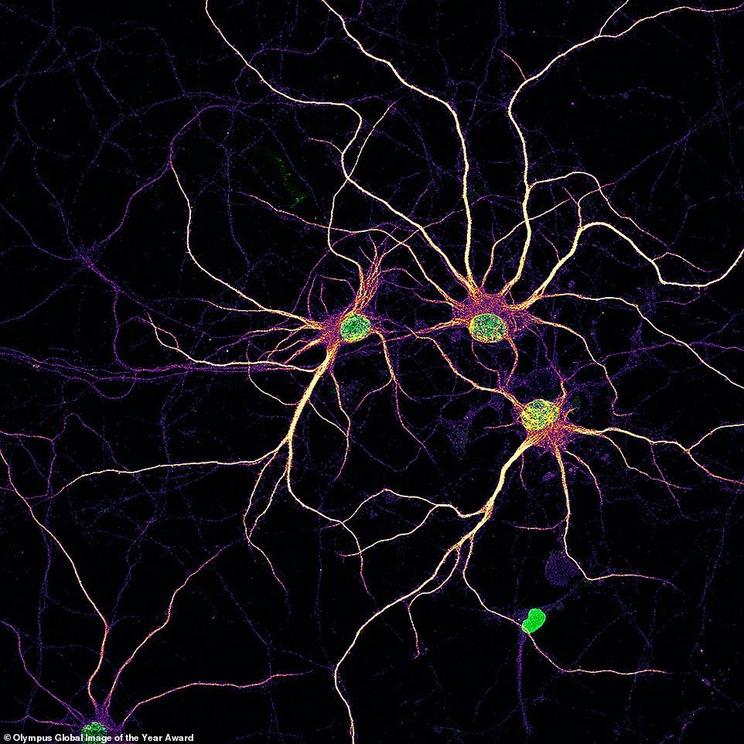 Cultured neurons are a good model to test enzyme replacement therapy (ERT) for many neurological disorders. In this experiment Efimova looked at uptake of engineered enzyme in rat cortical neuron
Cultured neurons are a good model to test enzyme replacement therapy (ERT) for many neurological disorders. In this experiment Efimova looked at uptake of engineered enzyme in rat cortical neuron
An incredible confocal image of collagen fibers (second harmonic generation) and dermal pigment cells (autofluorescence) in African house snake embryonic skin from Grigorii Timin, Switzerland, won the EMEA section.
Timin used the same microscope as Zuschratter to capture the glittery fibers and deep blue cells.
In the Asia-Pacific section, scales collected from the wings of over 40 species of butterflies were photographed individually and thoughtfully assembled into the winning image from XinPei Zhang, China .
Each butterfly shows complex details, coloring and contrast, and have all been intricately placed to create the mesmerizing image.
Lee Wagstaff, Vice President, Life Science Sales and Marketing, Olympus Corporation of the Americas told IFLScience: 'Our aim for the competition is to demonstrate both the artistic and scientific value of images captured under the microscope and further, to encourage people in every corner of the world to look at scientific images in a new way, appreciate their beauty, and share with each other.'
